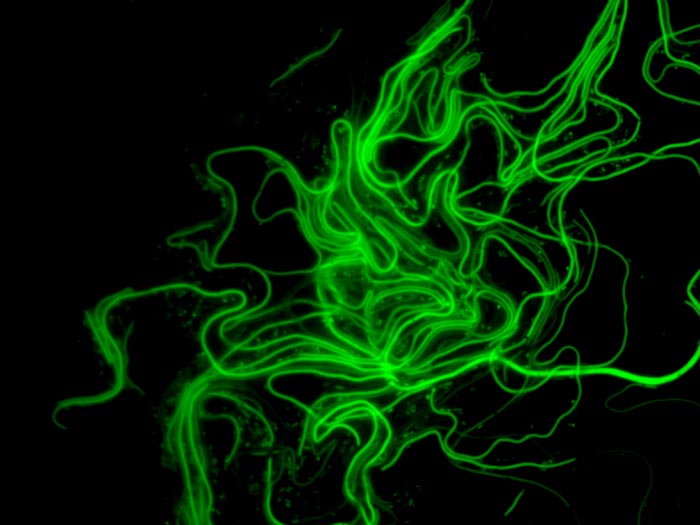Bacteria’s shapeshifting behaviour clue to new treatments for urinary tract infections

UPEC filaments expressing Green Fluorecent Protein (GFP) after exfoliation from bladder cells, captured using epi fluorescence microscopy.
Credit: Australian Institute for Microbiology and Infection, University of Technology Sydney /
Usage Restrictions
Single use only - for publication with this research
Rise of antimicrobial resistance adds urgency to research.
Urinary tract infections are both very common and potentially very dangerous. More than half of all Australian women will suffer from a UTI in their lifetime, and nearly one in three women will have an infection requiring treatment with antibiotics before the age of 24.
Around 80 per cent of UTIs are caused by uropathogenic E. coli (UPEC), which is increasingly resistant to antibiotics. E. coli-related death due to antimicrobial resistance is the leading cause of bacterial fatalities worldwide.
In a bid to aid discovery of new treatment options, researchers at the University of Technology Sydney (UTS) are using state-of-the-art microscopy to pinpoint how these bacteria spread and multiply.
Dr Bill Söderström and Associate Professor Iain Duggin, of the Australian Institute for Microbiology and Infection at UTS, said their latest research examined the shapeshifting behaviour of UPEC. During a UTI infection cycle, the bacteria form spaghetti-like filaments hundreds of times their normal lengths before reverting to their original form.
The study, which is published in Nature Communications, used a human bladder cell infection model to generate the filaments, and look at their reversal back to rod shape.
“While we don’t fully understand why they do this extreme lifestyle make-over, we know they must revert to their original size before they can reinfect new bladder cells,” Dr Söderström said.
“We used advanced microscopy to follow two key cell division proteins and their localisation dynamics during reversal. We found that the normal rules for regulation of cell division in bacteria does not fully apply in filaments,” Dr Söderström said.
“By giving the first clues into how the reversal of filamentation is regulated during infection, we may be laying the foundation for identifying new ways to combat UTIs.”
Associate Professor Duggin said the long filaments formed by the bacteria appeared to break open the infected human cells, through a previously unknown mechanism called infection-related filamentation (IRF).
“The devastating eruption of these bacteria from the cells of the bladder that they invade probably contributes to the extensive damage and pain experienced during a UTI,” Associate Professor Duggin said.
“Our goal is to identify why and how the bacteria do this remarkable feat in the hope of enabling alternative treatments or preventions.”
Journal: Nature Communications
DOI: 10.1038/s41467-022-31378-1
Method of Research: Experimental study
Subject of Research: Cells
Article Title: Assembly dynamics of FtsZ and DamX during infection-related filamentation and division in uropathogenic E. coli
Article Publication Date: 25-Jun-2022
COI Statement: The authors declare no competing interests.
All latest news from the category: Life Sciences and Chemistry
Articles and reports from the Life Sciences and chemistry area deal with applied and basic research into modern biology, chemistry and human medicine.
Valuable information can be found on a range of life sciences fields including bacteriology, biochemistry, bionics, bioinformatics, biophysics, biotechnology, genetics, geobotany, human biology, marine biology, microbiology, molecular biology, cellular biology, zoology, bioinorganic chemistry, microchemistry and environmental chemistry.
Newest articles

Innovative 3D printed scaffolds offer new hope for bone healing
Researchers at the Institute for Bioengineering of Catalonia have developed novel 3D printed PLA-CaP scaffolds that promote blood vessel formation, ensuring better healing and regeneration of bone tissue. Bone is…

The surprising role of gut infection in Alzheimer’s disease
ASU- and Banner Alzheimer’s Institute-led study implicates link between a common virus and the disease, which travels from the gut to the brain and may be a target for antiviral…

Molecular gardening: New enzymes discovered for protein modification pruning
How deubiquitinases USP53 and USP54 cleave long polyubiquitin chains and how the former is linked to liver disease in children. Deubiquitinases (DUBs) are enzymes used by cells to trim protein…



